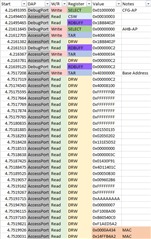Other Parts Discussed in Thread: UNIFLASH,
Tool/software:
Hello,
I'm trying to read the MAC address of a CC2340R5 chip using an SWD connection.
I can successfully retrieve the MAC address using Uniflash by reading the address range 0x4E000058-0x4E00005C, using TI development boards LP-XDC110ET and LP-EM-CC2340R5.
I understand that the MAC address is stored in the FCFG (specifically in .deviceInfo.macAddr).
I have a few questions:
- The SACI_CMD_MISC_GET_DIE_ID command returns the Die ID (also stored in the FCFG), and the SACI_CMD_MISC_GET_CCFG_USER_REC command returns the user record. Is there a way to directly access the MAC address, or perhaps access the entire FCFG, using only SACI commands or the Debug Sub-System Mailbox?
- I added tracing on the SWD lines to monitor the sequence of Debug Access Port commands used by Uniflash to read the MAC Address. However, when I try to replicate this sequence of commands, I don't receive any return values from the address. I've included the list of commands in the image below. Is there something else I need to do beforehand in order to access the contents at address 0x4E000058?

I am looking forward to hear from you, feel free to ask me any questions.
Regards,
Eduardo

